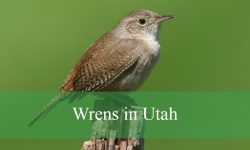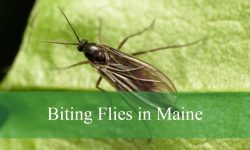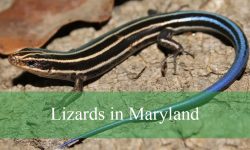Texas is home to an impressive variety of wildlife, and among its most fascinating inhabitants are the types of snakes in Texas. With diverse landscapes ranging from deserts and forests to wetlands and grasslands, Texas provides ideal habitats for many snake species. Understanding these snakes is important for both safety and appreciation of the natural world.
The snakes in Texas include both venomous and non-venomous species, each playing a unique role in the ecosystem. From the well-known Western Diamond-backed Rattlesnake to the elusive Texas Lyre Snake, this state’s snake population is diverse and abundant. Correct identification helps prevent misunderstandings and promotes coexistence.
This article presents detailed descriptions and pictures of 64 different types of snakes in Texas, helping readers recognize and learn more about these intriguing reptiles. The guide covers venomous species as well as harmless ones, providing valuable information for anyone interested in Texas’s rich snake diversity.
Venomous Snakes in Texas
Western Diamond-backed Rattlesnake (Crotalus atrox)
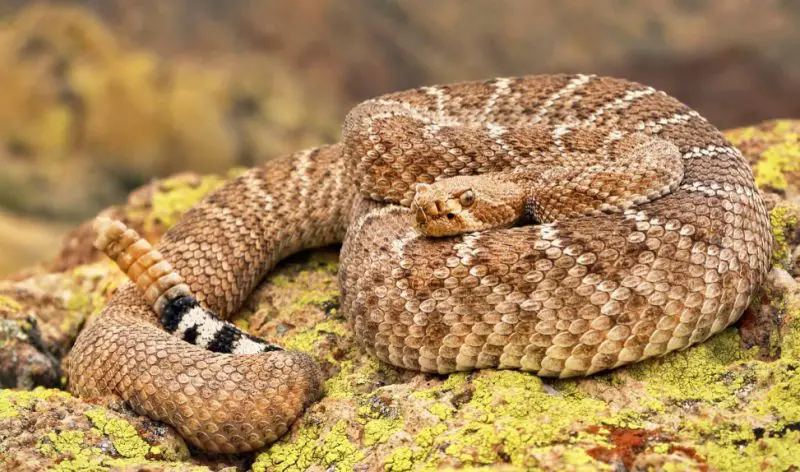
The Western Diamond-backed Rattlesnake is one of the most iconic and widely recognized snakes in Texas. It is a large pit viper, often growing over 4 feet long, with a thick body and distinctive diamond-shaped patterns running along its back. Its coloration typically ranges from gray to brown with dark brown or black markings, and the tail features alternating black and white rings ending in a prominent rattle.
This rattlesnake is commonly found in arid regions, grasslands, deserts, and rocky outcroppings throughout central and western Texas. It prefers areas with cover such as brush piles, cacti, or abandoned burrows and is often seen basking on roads or trails. The Western Diamondback is generally solitary and active mostly during the evening or at night, especially in hot weather.
Its diet includes small mammals like rats, mice, rabbits, and birds. It uses its heat-sensing pits to locate prey, delivers a venomous bite to immobilize it, and then swallows it whole. The venom is hemotoxic, affecting blood and tissues, and can be dangerous to humans if untreated. However, this rattlesnake usually gives a warning rattle before striking and will often retreat if given the chance.
Eastern Copperhead (Agkistrodon contortrix)

The Eastern Copperhead is a medium-sized venomous snake with a robust body and distinctive copper-colored head. Its body is typically light tan to pinkish-tan with hourglass-shaped bands that are darker brown and often outlined in black. These bands help the snake blend in with fallen leaves and forest floor debris.
It is primarily found in eastern and northeastern Texas, inhabiting woodlands, rocky hillsides, and areas near streams or swamps. The Eastern Copperhead is highly camouflaged and tends to freeze when disturbed, relying on its coloration for protection rather than fleeing. It is active during the day in cooler months and becomes more nocturnal during summer.
The snake’s diet includes insects, frogs, small rodents, and lizards. Juveniles often use their bright yellow-tipped tails to lure prey—a behavior called caudal luring. The venom of the Eastern Copperhead is relatively mild compared to other pit vipers, but it still causes pain, swelling, and tissue damage. Bites are rarely fatal but should always be treated by medical professionals.
Broad-banded Copperhead (Agkistrodon laticinctus)
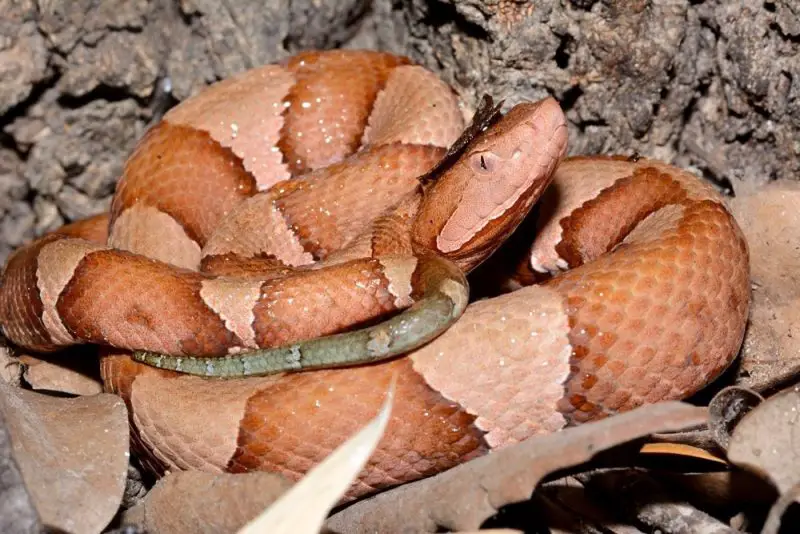
The Broad-banded Copperhead is closely related to the Eastern Copperhead but has broader and more evenly spaced bands across its body. It usually has a pale tan to light brown base color with rich, reddish-brown crossbands. Its head is distinctively shaped and coppery in color, with vertical pupils and heat-sensing pits.
This species is found in central and western Texas, especially in dry rocky areas, brushlands, and oak-juniper woodlands. It is less common than the Eastern Copperhead but can be found in similar environments, often sheltering under rocks or logs. The Broad-banded Copperhead is relatively docile and rarely aggressive, preferring to remain still and avoid detection.
Its diet consists of small mammals, amphibians, insects, and occasionally other reptiles. Like its relatives, it uses ambush tactics and heat sensors to catch prey. Its venom is also hemotoxic, causing localized pain and swelling but is seldom life-threatening. Most bites occur when the snake is accidentally stepped on due to its excellent camouflage.
Northern Cottonmouth (Agkistrodon piscivorus)
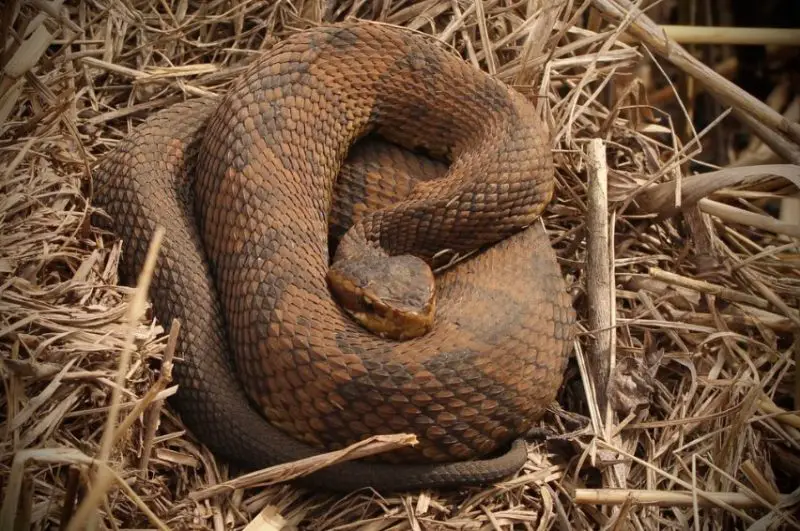
The Northern Cottonmouth, often called a “water moccasin,” is a heavy-bodied, semi-aquatic snake known for its aggressive reputation and fearsome gape display. Adults are usually dark brown to black with faint crossbands, and juveniles have brighter patterns and a yellow-tipped tail. Its mouth lining is bright white, which it shows when threatened.
This species is found in eastern Texas, especially in swamps, slow-moving rivers, marshes, ponds, and other wetland environments. It is an excellent swimmer and often basks on logs or rocks near water. Though often perceived as aggressive, it generally prefers to avoid confrontation and will flee if possible, resorting to defensive posturing only when cornered.
The Northern Cottonmouth feeds on fish, frogs, small mammals, and other snakes. It uses venom to immobilize prey and then swallows it whole. Its venom is both hemotoxic and cytotoxic, capable of causing severe tissue damage. While bites are rare, they are more serious than those from copperheads and require prompt medical attention.
Timber Rattlesnake (Crotalus horridus)
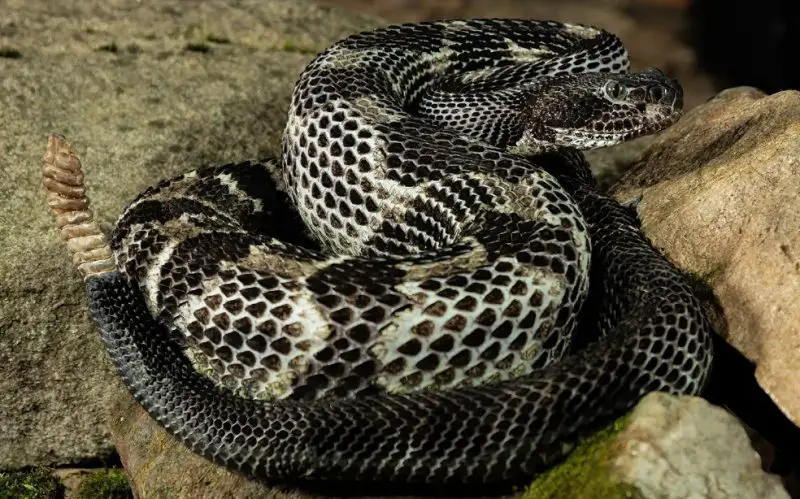
The Timber Rattlesnake is a large, heavy-bodied viper known for its calm demeanor and striking black tail. It typically has a yellowish-brown to gray base color with dark V- or chevron-shaped crossbands. The head is broad and triangular, and a reddish-brown stripe often runs down the spine.
In Texas, Timber Rattlesnakes are primarily found in the eastern part of the state, inhabiting deciduous forests, wooded hillsides, and rocky bluffs. They prefer undisturbed habitats with plenty of ground cover and are mostly active during late spring to early fall. Despite their size and potency, they are generally non-aggressive and rely on their camouflage to avoid detection.
Their diet includes rodents, squirrels, birds, and other small vertebrates. The Timber Rattlesnake delivers a strong hemotoxic venom that can be lethal without treatment, though fatalities are rare thanks to the availability of antivenom. The snake will usually give a warning rattle before striking and prefers escape over conflict when possible.
Western Massasauga (Sistrurus tergeminus)

The Western Massasauga is a small, secretive rattlesnake that rarely exceeds 2 feet in length. It is light gray to tan in color with darker brown blotches running down the back and smaller spots on the sides. Its head is distinct and triangular, and it has vertical pupils and a small rattle at the tip of the tail. Compared to larger rattlesnakes, the Western Massasauga has a more slender build.
In Texas, this species is found in the central and northern regions, particularly in prairies, grasslands, and open scrub. It prefers areas with loose, well-drained soils where it can burrow or hide under rocks and logs. This snake is primarily nocturnal and avoids human activity, making it one of the more elusive venomous snakes in the state.
The Western Massasauga preys on small mammals, lizards, and amphibians, using its mild venom to subdue prey. Although its venom is hemotoxic, the quantity delivered is relatively small, and bites to humans are rare and typically not life-threatening. It is a shy species that prefers retreating over confrontation, often relying on camouflage and stillness to avoid detection.
Texas Coral Snake (Micrurus tener)
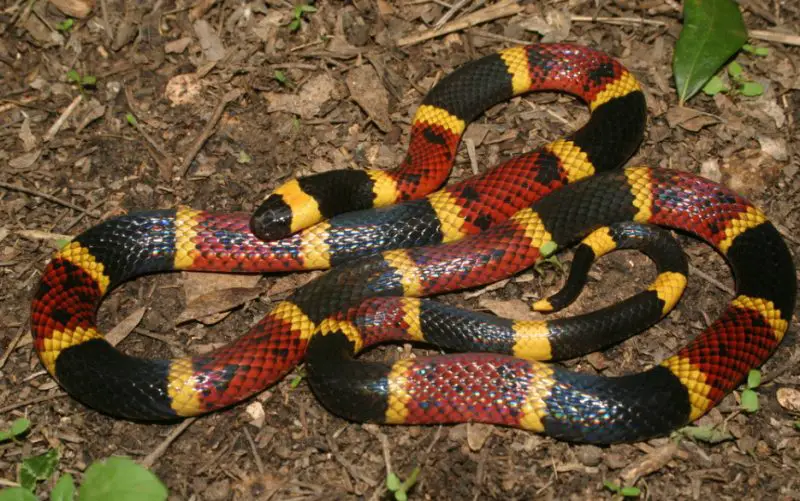
The Texas Coral Snake is a slender, brightly colored species easily identified by its striking bands of red, yellow, and black. The distinctive color pattern follows the rhyme “red on yellow, kill a fellow” to differentiate it from non-venomous mimics like the milk snake. Coral snakes have small heads and smooth scales, with rounded pupils and no visible heat-sensing pits.
This snake is found in the southeastern and central parts of Texas, often in forested areas, sandy woodlands, and pine flatwoods. It is secretive and rarely seen, spending much of its time hidden under leaf litter, logs, or rocks. The Texas Coral Snake is primarily nocturnal and tends to be more active after heavy rains or during warm, humid nights.
Its diet consists mostly of other reptiles, including small snakes and lizards. The coral snake delivers a potent neurotoxic venom that affects the nervous system and can be dangerous without prompt medical care. However, it is reclusive and bites are exceedingly rare, as it must chew to deliver venom and typically avoids human contact.
Pygmy Rattlesnake (Sistrurus miliarius)

The Pygmy Rattlesnake is a small rattlesnake species rarely exceeding 20 inches in length. It is typically gray with a row of dark spots down the back, often accompanied by a reddish stripe running along the spine. Its rattle is very small and produces a soft, buzzing sound that can be difficult to hear.
In Texas, the Pygmy Rattlesnake occurs mainly in the eastern part of the state, favoring pine forests, hardwood bottoms, and sandy scrublands. It tends to stay hidden under logs, leaf litter, or debris and is more active during cooler times of the day. Despite its size, it can be quite bold and may stand its ground if threatened.
The diet of this snake includes small frogs, lizards, mice, and insects. It uses venom to immobilize its prey and swallows it whole. Though its venom is hemotoxic, it is considered relatively mild, and bites are seldom serious to healthy adults. Its small size and cryptic behavior mean that encounters with humans are infrequent.
Prairie Rattlesnake (Crotalus viridis)

The Prairie Rattlesnake is a medium to large rattlesnake that can grow up to 4 feet in length. Its color ranges from greenish-gray to brown with a series of dark brown blotches bordered by lighter rings. The head is triangular, and the eyes have vertical pupils. This species has a noticeable rattle and a strong, muscular build.
This snake is primarily found in the western Texas Panhandle and parts of the Trans-Pecos region, often inhabiting grasslands, rocky hills, and canyons. It is both terrestrial and somewhat arboreal, sometimes climbing shrubs or low trees. The Prairie Rattlesnake is active during the day in cooler months and becomes nocturnal during hotter weather.
Its diet includes rodents, birds, lizards, and frogs. The venom is hemotoxic and can cause significant swelling and pain, but fatalities are rare when proper medical care is administered. The Prairie Rattlesnake generally gives a warning rattle before striking and will usually retreat when given the opportunity.
Mojave Rattlesnake (Crotalus scutulatus)

The Mojave Rattlesnake is a highly venomous species known for its potent neurotoxic venom. It is usually light greenish-brown or tan with dark diamond-shaped markings bordered by lighter scales, similar in appearance to the Western Diamondback. It can be distinguished by its tail bands, which are more uniform in color and narrower than those of other rattlesnakes.
In Texas, this snake is primarily found in the far western part of the state, particularly in arid desert regions, grasslands, and scrubby hills. It prefers dry, open habitats with sparse vegetation and is often encountered on desert roads or trails. The Mojave Rattlesnake is active during warm seasons and becomes nocturnal in extreme heat.
It preys on small mammals, birds, and reptiles, using its venom to quickly incapacitate its targets. Unlike most rattlesnakes, its venom contains both hemotoxic and neurotoxic components, which can cause paralysis or respiratory failure if left untreated. Though it is highly dangerous, the Mojave Rattlesnake is not aggressive unless threatened and will often flee when given the chance.
Black-tailed Rattlesnake (Crotalus molossus)

The Black-tailed Rattlesnake is a medium-sized rattlesnake, typically ranging from 2.5 to 4 feet in length. It has a slender body with a distinctive black tail, which gives the species its name. Its coloration varies from gray to tan or light brown, marked with darker blotches or bands along its back that provide excellent camouflage in its rocky and desert surroundings.
In Texas, this rattlesnake is primarily found in the western and southwestern regions, especially in desert scrublands, rocky slopes, and canyons. It favors dry habitats with ample cover such as boulders, crevices, and brush. The Black-tailed Rattlesnake is generally nocturnal during the hotter months and may be more active during daylight in cooler weather.
Its diet mainly consists of small mammals, birds, and reptiles. This rattlesnake uses hemotoxic venom to immobilize prey, which causes tissue damage and swelling in bite victims. While not usually aggressive, it will defend itself if threatened and produces a characteristic rattling sound as a warning before striking.
Banded Rock Rattlesnake (Crotalus lepidus)
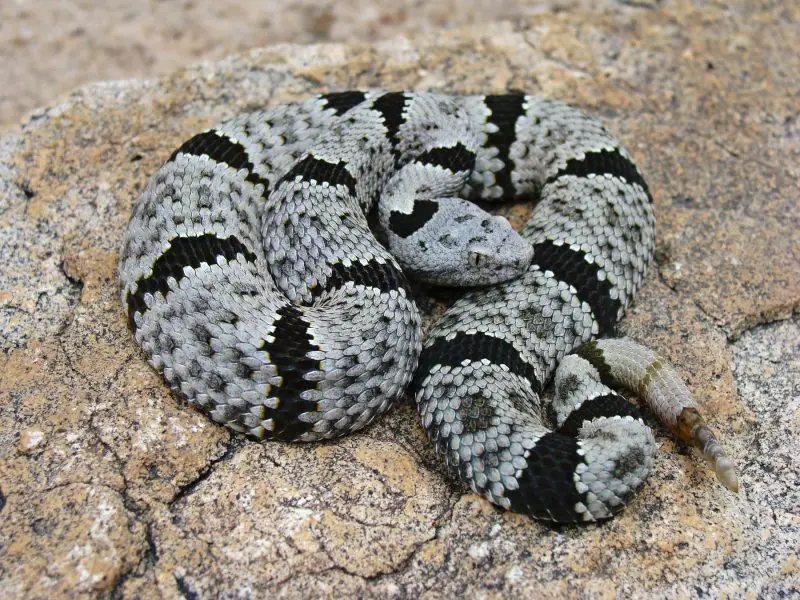
The Banded Rock Rattlesnake is a smaller rattlesnake species, usually measuring between 18 and 30 inches. It is known for its striking banded pattern of black, gray, and white or light brown bands that blend perfectly with the rocky habitats it frequents. Its slender body and relatively small rattle make it a more delicate-looking species compared to other rattlesnakes.
This rattlesnake inhabits rocky outcrops, cliffs, and mountainous areas in western Texas, including the Trans-Pecos region. It is an excellent climber and can often be found sunning itself on rocks or hiding in crevices. The Banded Rock Rattlesnake is secretive and primarily nocturnal or crepuscular, avoiding the heat of midday.
Its diet consists of lizards, small rodents, and occasionally insects. The venom is hemotoxic and mild compared to other rattlesnakes, causing localized pain and swelling but rarely life-threatening. The Banded Rock Rattlesnake is typically shy and will avoid humans when possible, relying on its camouflage and quiet demeanor to escape danger.
Desert Massasauga (Sistrurus tergeminus edwardsii)
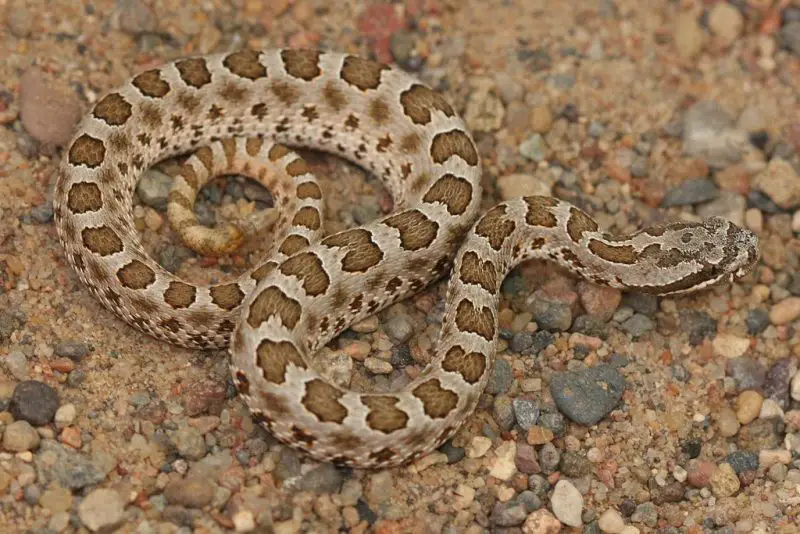
The Desert Massasauga is a subspecies of the Western Massasauga and is generally smaller, growing to about 18-24 inches. It has a light gray or tan body with dark brown or black blotches running along its back, often with smaller spots on the sides. It has a triangular head and a small rattle, though the rattle sound is quieter than larger rattlesnakes.
In Texas, this snake is found primarily in the western and southwestern desert regions, favoring dry grasslands, desert flats, and rocky areas with sparse vegetation. It tends to be elusive and spends much of its time hidden under rocks or in burrows to avoid predators and extreme heat.
The Desert Massasauga feeds on small mammals, amphibians, and reptiles. Its venom is hemotoxic but relatively mild compared to larger rattlesnakes, posing less danger to humans. This snake is non-aggressive and will typically freeze or retreat when disturbed, using its excellent camouflage to avoid threats.
Non-Venomous Snakes in Texas
Texas Rat Snake (Pantherophis obsoletus lindheimeri)
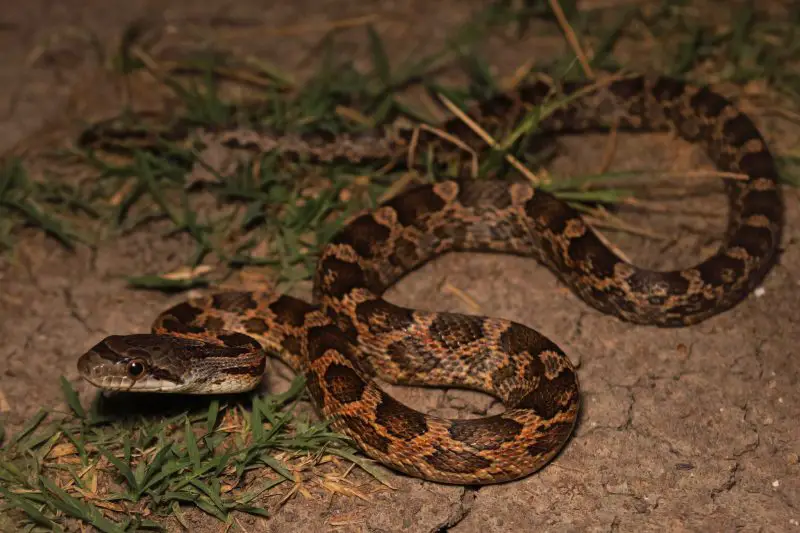
The Texas Rat Snake is a large, non-venomous constrictor that can grow up to 6 feet in length. It has a glossy black or dark brown body with lighter undersides, sometimes showing faint blotches or patterns. Its smooth scales and slender body help it move swiftly through trees and underbrush. This snake is often mistaken for venomous species due to its size and coloration.
In Texas, it is widespread throughout the eastern and central parts of the state, commonly inhabiting forests, farmlands, and suburban areas. It is an excellent climber, frequently found in trees and barns, where it hunts for rodents. Texas Rat Snakes are mostly nocturnal but can also be active during the day, especially in cooler weather.
Its diet mainly consists of rodents, birds, eggs, and occasionally amphibians. The Texas Rat Snake kills by constriction, wrapping its coils around prey until suffocation. It is non-venomous and generally docile, although it may vibrate its tail and mimic rattlesnakes when threatened. This behavior, combined with its size, sometimes causes unnecessary fear.
Western Ribbon Snake (Thamnophis proximus)

The Western Ribbon Snake is a slender, fast-moving snake measuring about 18 to 30 inches. It is characterized by its three distinctive yellow or white stripes running lengthwise along its black or dark brown body. Its head is small and narrow with round pupils, giving it a delicate appearance compared to bulkier snakes.
This species inhabits wetlands, marshes, and grassy areas throughout much of Texas, particularly in the eastern and central regions. It is highly aquatic and often found near streams, ponds, or lakes, where it can swim efficiently. Western Ribbon Snakes are diurnal and often seen basking on rocks or vegetation near water.
The Western Ribbon Snake feeds mainly on amphibians, small fish, and insects. It is a non-venomous species that subdues prey through quick strikes and swallowing whole. Despite its striking appearance, it is harmless to humans and tends to flee quickly when approached.
Eastern Garter Snake (Thamnophis sirtalis)
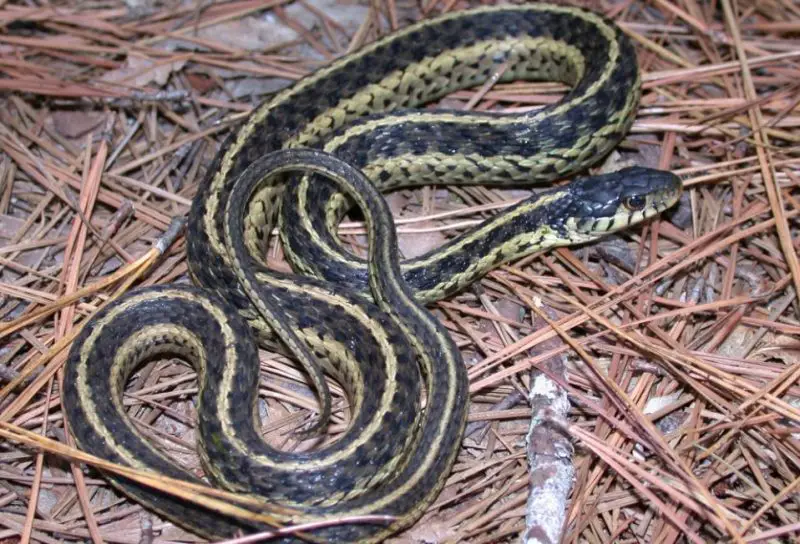
The Eastern Garter Snake is a common and adaptable species found in a variety of habitats across Texas. It typically grows between 18 and 26 inches and is recognizable by three yellow or white stripes running down its olive, brown, or black body. Its scales are keeled, giving it a rough texture.
This snake thrives in gardens, forests, meadows, and near water bodies such as ponds and streams. It is mostly diurnal and enjoys basking in the sun but can be active at various times depending on weather conditions. The Eastern Garter Snake is one of the most frequently encountered snakes in suburban and rural Texas.
Its diet consists of amphibians, earthworms, small fish, and rodents. The Eastern Garter Snake produces mild venom to subdue prey, which is harmless to humans. It is non-aggressive and often flattens its body and releases a foul-smelling musk when threatened as a defense mechanism.
Coachwhip (Masticophis flagellum)
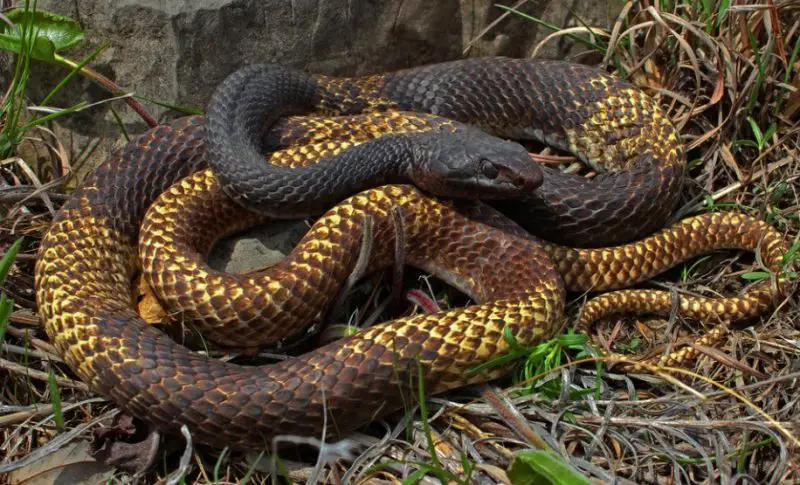
The Coachwhip is a long, slender snake that can reach lengths of 6 to 8 feet, making it one of the longest snakes in Texas. It is named for its tail, which resembles a braided whip. Its coloration varies widely but often includes tan, brown, or reddish hues with a smooth, glossy appearance that helps it blend into dry, sandy environments.
In Texas, Coachwhips are commonly found in open, arid areas such as deserts, prairies, and scrublands. They are active during the day and are known for their speed and agility. This species is highly visual and uses its excellent eyesight to hunt and avoid predators.
The Coachwhip preys on lizards, small mammals, birds, and other snakes. It is non-venomous and kills by constriction or rapid swallowing. Despite its intimidating size and speed, it is generally not aggressive towards humans and will often retreat quickly if disturbed.
Bullsnake (Pituophis catenifer sayi)
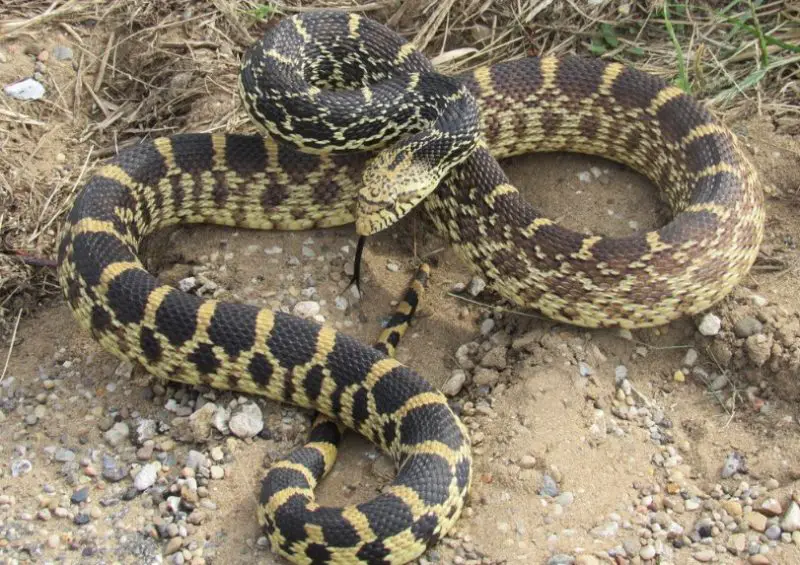
The Bullsnake is a large, powerful constrictor that can grow up to 8 feet long, making it one of Texas’s biggest non-venomous snakes. It has a yellow or cream-colored body with black or dark brown blotches running along the back and sides. Its head is broad and slightly pointed, and it often mimics rattlesnakes by hissing loudly and vibrating its tail.
This snake is widespread in Texas, favoring open fields, farmlands, and grasslands where it can burrow and hunt. It is primarily terrestrial and spends much time underground or under rocks. Bullsnakes are mostly active during the day but may be crepuscular in hot weather.
Bullsnakes feed mainly on rodents, birds, and eggs, making them beneficial for controlling pests. They kill by constriction and are non-venomous. Their intimidating defensive behavior, including loud hissing and tail rattling, often deters predators and humans alike, though they rarely bite.
Texas Indigo Snake (Drymarchon melanurus erebennus)
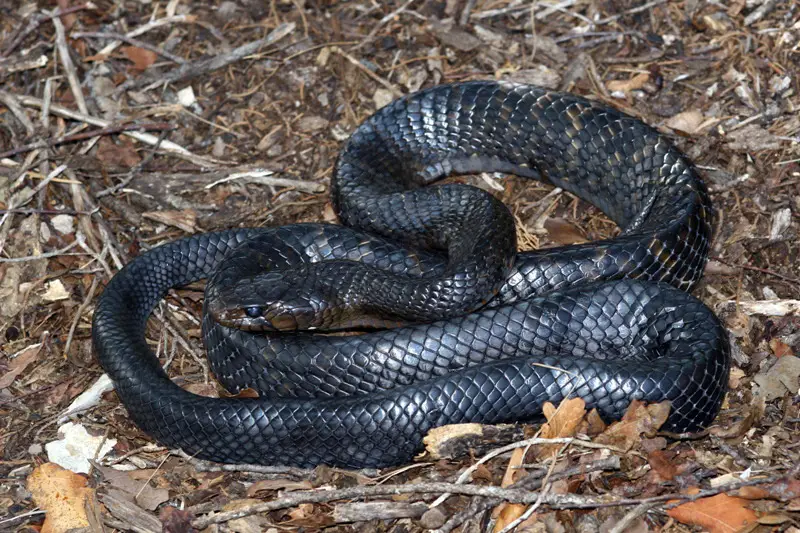
The Texas Indigo Snake is a large, robust snake, typically reaching lengths of 5 to 7 feet. It is known for its glossy, iridescent black or dark blue scales that shimmer in sunlight, giving it a striking appearance. This species has a broad head and powerful body, making it one of the most impressive snakes in Texas.
Found mainly in southern and central Texas, the Texas Indigo Snake inhabits diverse environments, including forests, grasslands, and scrublands. It favors areas with plenty of cover like logs, burrows, and dense vegetation. This snake is primarily diurnal and highly active during warmer months.
Texas Indigo Snakes are opportunistic feeders, preying on rodents, birds, eggs, lizards, and even other snakes, including venomous species. They kill by constriction and are non-venomous. Due to their size and fearless behavior, they play a vital role in controlling populations of various small animals.
Checkered Garter Snake (Thamnophis marcianus)

The Checkered Garter Snake is a medium-sized, slender snake, growing up to 3 feet long. It features a distinctive checkerboard pattern of black and yellow or greenish squares along its back, which sets it apart from other garter snakes. Its head is small with round pupils, and the body is smooth-scaled.
In Texas, this snake is commonly found in the southern and eastern regions, particularly near water bodies such as marshes, ponds, and rivers. It prefers wet habitats but can also be found in grasslands and fields. The Checkered Garter Snake is mostly diurnal and very active during the day.
This species feeds mainly on amphibians, fish, earthworms, and small mammals. Although non-venomous, it produces mild saliva toxins that help subdue prey. It is generally harmless to humans and tends to flee when threatened, relying on its speed and agility.
Plains Garter Snake (Thamnophis radix)
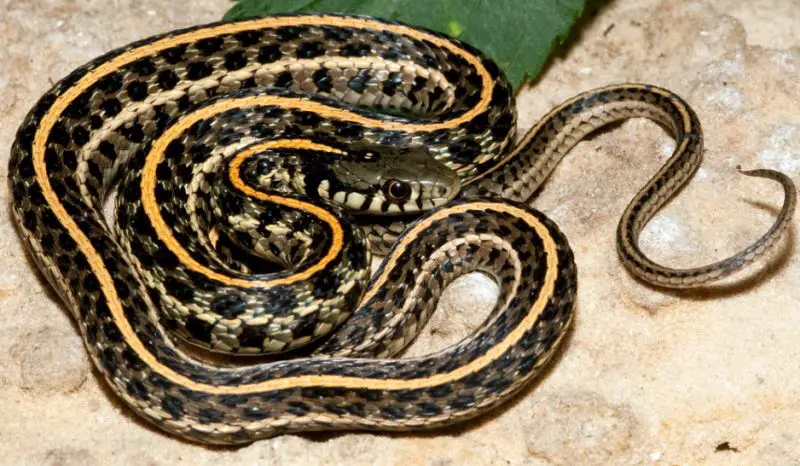
The Plains Garter Snake is a slender, medium-sized snake that typically grows between 18 and 30 inches long. It has three yellow or white stripes running longitudinally down its olive, brown, or gray body, with smaller black spots or checkerboard patterns in between. Its scales are keeled, giving it a slightly rough texture.
This snake inhabits grasslands, prairies, and wetlands across northern and western Texas. It is semi-aquatic and often found near streams, ponds, or marshes. The Plains Garter Snake is primarily diurnal and relies on its speed to escape predators and hunt prey.
Its diet includes amphibians, small fish, earthworms, and insects. The Plains Garter Snake is non-venomous and kills prey by quick strikes and swallowing whole. It is harmless to humans and usually retreats quickly when disturbed.
Eastern Hognose Snake (Heterodon platirhinos)

The Eastern Hognose Snake is a medium-sized snake, measuring around 20 to 35 inches in length. It is named for its distinctive upturned snout, which it uses for digging in sandy soils. Its coloration varies widely, including shades of brown, gray, and olive, often with dark blotches or spots on its back.
In Texas, the Eastern Hognose Snake is found primarily in the eastern and northeastern regions, inhabiting sandy woods, fields, and prairies. It is primarily terrestrial and spends much of its time burrowing or hiding under leaf litter. This species is diurnal and most active in warmer months.
The Eastern Hognose Snake feeds mainly on amphibians, especially toads, which it is immune to their toxins. It is mildly venomous to its prey but harmless to humans. When threatened, it may hiss loudly, flatten its neck to appear larger, and even play dead to avoid predators.
Western Hognose Snake (Heterodon nasicus)
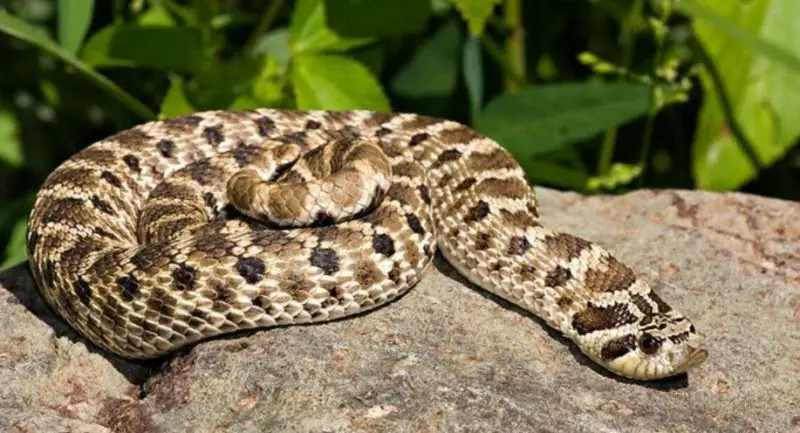
The Western Hognose Snake is a smaller, stout-bodied snake typically 14 to 24 inches long. Like its eastern counterpart, it has a characteristic upturned snout used for digging. Its coloration includes shades of brown, tan, and gray with darker blotches, providing excellent camouflage in its habitat.
This species is found in the Texas Panhandle and northern parts of the state, inhabiting dry grasslands, prairies, and sandy soils. It is primarily terrestrial and uses its snout to burrow in loose soil. The Western Hognose is diurnal and tends to be active during the day, especially in spring and fall.
Western Hognose Snakes feed on amphibians, small reptiles, and occasionally rodents. They possess mild venom used to subdue prey but are not dangerous to humans. Their defensive behavior includes flattening the neck, hissing, and playing dead when threatened.
Speckled Kingsnake (Lampropeltis holbrooki)
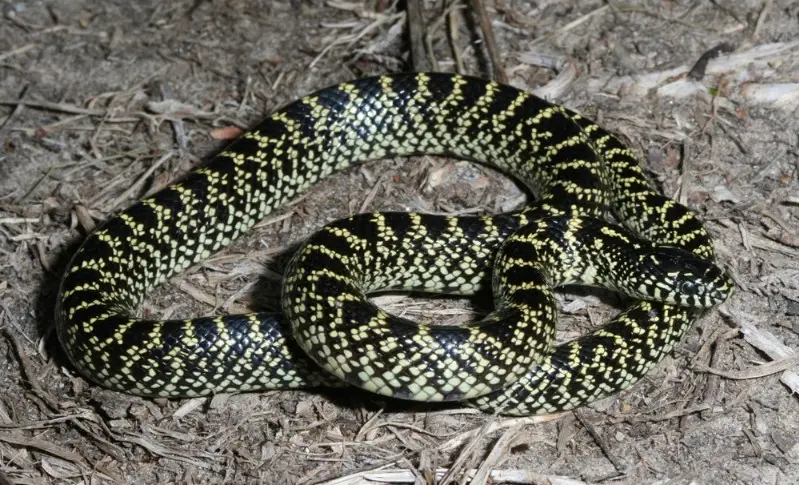
The Speckled Kingsnake is a medium to large snake, reaching lengths of 3 to 4 feet. It is named for its distinctive black or dark brown body covered with small white or yellow speckles that create a starry appearance. The smooth scales and glossy sheen make it visually striking among Texas snakes.
This species is found throughout eastern Texas, favoring woodlands, fields, and near water sources such as rivers and ponds. It is a versatile and secretive snake, often hiding under rocks, logs, or leaf litter. The Speckled Kingsnake is mostly nocturnal but can also be active during the day in cooler weather.
Speckled Kingsnakes are constrictors that prey on rodents, birds, amphibians, and other snakes, including venomous species. They are non-venomous and known for their immunity to pit viper venom, allowing them to prey on rattlesnakes and copperheads. When threatened, they may vibrate their tails and release a musky odor.
Milk Snake (Lampropeltis triangulum)
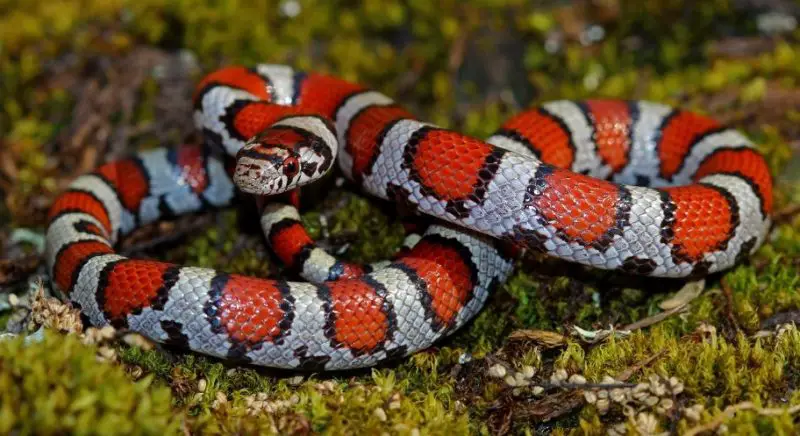
Milk Snakes are medium-sized snakes typically ranging from 20 to 40 inches in length. They are known for their beautiful pattern of red, black, and white or yellow bands that can sometimes be confused with the venomous coral snake. Their smooth scales and slender bodies make them agile hunters.
In Texas, Milk Snakes are widespread, inhabiting forests, grasslands, and rocky areas. They are often found near farms and barns, where they help control rodent populations. Milk Snakes are primarily nocturnal but can be active during the day in cooler weather.
Milk Snakes prey on small mammals, birds, eggs, reptiles, and amphibians, killing prey by constriction. They are non-venomous and harmless to humans. When threatened, they may mimic rattlesnake behavior by vibrating their tails to scare off predators.
Texas Garter Snake (Thamnophis sirtalis annectens)

The Texas Garter Snake is a slender snake averaging 18 to 30 inches in length. It is recognized by its three yellow or white stripes running longitudinally down a dark brown or black body. Its keeled scales give it a slightly rough texture. This subspecies of the common garter snake is widespread in Texas.
This snake prefers moist habitats such as wetlands, marshes, and streams but can also be found in grasslands and urban areas. It is diurnal and often seen basking in the sun or swimming. The Texas Garter Snake is very adaptable and thrives in a variety of environments.
Its diet mainly consists of amphibians, earthworms, small fish, and insects. It produces a mild venom that helps subdue prey but is harmless to humans. The Texas Garter Snake is generally non-aggressive and will flee quickly if disturbed.
Prairie Kingsnake (Lampropeltis calligaster)
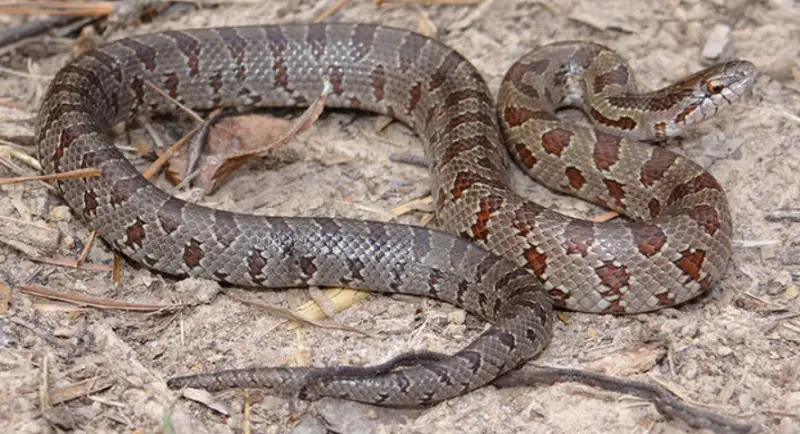
The Prairie Kingsnake is a medium-sized, non-venomous constrictor growing to about 24 to 40 inches in length. It has a light brown or tan body with darker brown blotches arranged in a pattern along its back. Its smooth scales and slender form aid its movement through grasslands and open woodlands.
This species is common in the central and eastern regions of Texas, often inhabiting prairies, fields, and edges of forests. It is primarily terrestrial and secretive, spending much of its time hiding under rocks or in burrows. Prairie Kingsnakes are mostly nocturnal but may be active during the day in cooler weather.
Prairie Kingsnakes feed on small mammals, lizards, birds, and other snakes. They kill by constriction and are non-venomous. When threatened, they may vibrate their tails or mimic rattlesnakes to deter predators.
Rough Green Snake (Opheodrys aestivus)
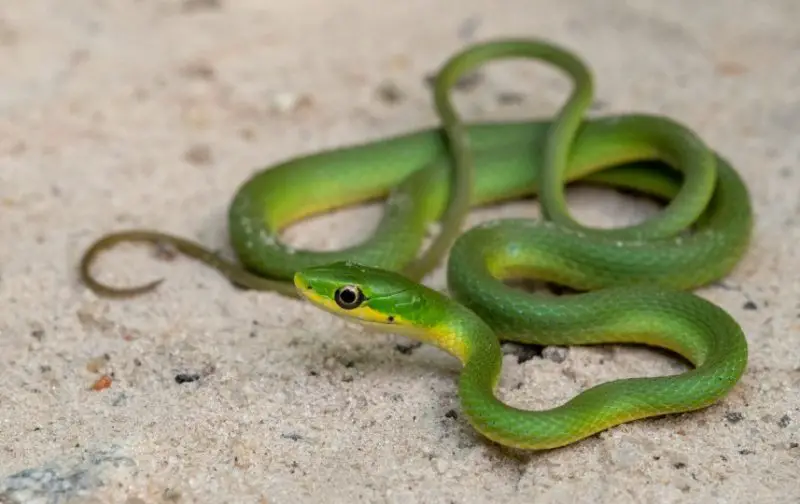
The Rough Green Snake is a slender, bright green snake that typically grows 20 to 30 inches long. Its smooth scales and vibrant coloration provide excellent camouflage among leaves and grasses. The belly is usually pale yellow or white, contrasting with the vivid green of its back.
This species is common in eastern Texas, inhabiting forests, shrublands, and wetlands. It is highly arboreal and diurnal, often seen climbing plants and trees while searching for food or basking in the sun. The Rough Green Snake prefers moist environments near water.
Its diet mainly consists of insects and spiders, making it an important pest controller. The Rough Green Snake is non-venomous and very gentle, rarely biting humans. It relies on its excellent camouflage and quick movements to avoid predators.
Eastern Racer (Coluber constrictor)
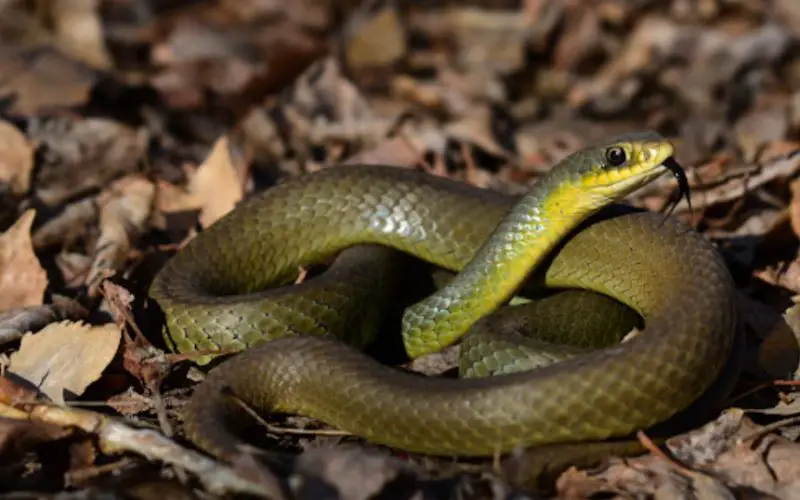
The Eastern Racer is a fast, slender snake typically ranging from 24 to 60 inches in length. It usually has a smooth, solid-colored body, often black, gray, or blue-gray, with a white or cream underside. Its large eyes and streamlined head make it an agile and alert predator.
In Texas, the Eastern Racer is widely distributed, inhabiting a variety of environments such as open fields, forests, and suburban areas. It is diurnal and known for its incredible speed, often fleeing quickly when disturbed. The snake is an excellent climber and swimmer as well.
Eastern Racers feed on a diverse diet, including rodents, birds, amphibians, and insects. They are non-venomous and subdue prey by biting and swallowing it whole. Generally harmless to humans, they may vibrate their tail or release a foul-smelling musk when threatened.
Smooth Earth Snake (Virginia valeriae)

The Smooth Earth Snake is a small, secretive snake averaging 7 to 10 inches in length. It has smooth, shiny scales with a coloration ranging from brown to gray or reddish, helping it blend into leaf litter and soil. Its small size and rounded snout assist in burrowing.
This species is found primarily in eastern Texas, inhabiting moist woodlands, gardens, and grassy areas. It spends much of its time underground or hidden under rocks, logs, and debris. The Smooth Earth Snake is mostly nocturnal and rarely seen during the day.
Its diet consists mainly of soft-bodied invertebrates such as earthworms, slugs, and insects. It is non-venomous and completely harmless to humans. Due to its secretive nature and small size, it is rarely encountered in the wild.
Rough Earth Snake (Haldea striatula)
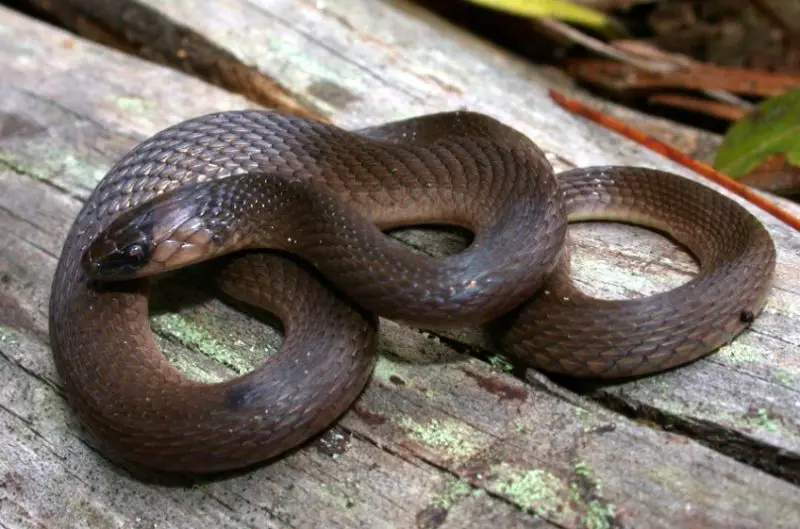
The Rough Earth Snake is a small, slender snake typically 7 to 12 inches long. Unlike the Smooth Earth Snake, it has keeled (rough-textured) scales, giving it a slightly ridged appearance. Its coloration is usually brown or gray with a lighter underside, aiding in camouflage.
In Texas, the Rough Earth Snake is commonly found in eastern and central parts, preferring moist woodlands, gardens, and fields. It is a fossorial species, spending much time burrowing or hiding under rocks and leaf litter. The Rough Earth Snake is mostly nocturnal or crepuscular.
This snake feeds on earthworms, insects, and other small invertebrates. It is non-venomous and poses no threat to humans. Its shy behavior makes it an elusive species rarely seen outside its underground retreats.
Texas Night Snake (Hypsiglena jani texana)
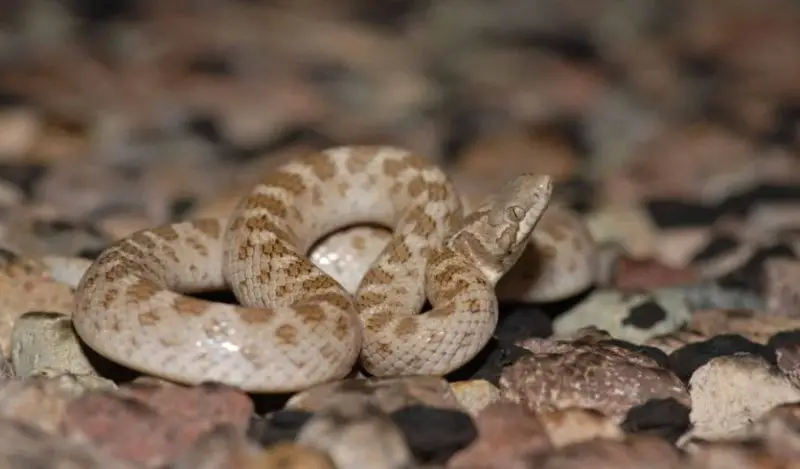
The Texas Night Snake is a small to medium-sized snake, growing up to about 20 inches long. It has smooth scales and a gray or light brown body marked with dark blotches or saddles along its back. Its head is slightly wider than its neck with vertical pupils, typical of nocturnal snakes.
This species is mostly nocturnal and found in central and western Texas, inhabiting rocky hillsides, deserts, and dry grasslands. It is secretive and spends daylight hours hidden under rocks or in burrows. The Texas Night Snake is well adapted to arid environments.
It primarily feeds on lizards, amphibians, and small snakes. Although it is mildly venomous to its prey, it is harmless to humans. When threatened, it may flatten its head or vibrate its tail to mimic venomous species.
Great Plains Rat Snake (Pantherophis emoryi)

The Great Plains Rat Snake is a large, slender snake that can reach lengths of 48 to 72 inches. It features a light tan or gray body with dark blotches or saddles running down its back. Its smooth scales and muscular build make it an adept climber and hunter.
This species is found in the northern and western regions of Texas, inhabiting grasslands, prairies, and rocky outcrops. It is mostly terrestrial but also climbs trees and shrubs in search of prey. The Great Plains Rat Snake is primarily nocturnal or crepuscular.
Its diet consists mainly of rodents, birds, eggs, and small reptiles. It kills prey by constriction and is non-venomous. Known for its defensive behavior, it may emit a foul odor or vibrate its tail when threatened but is generally non-aggressive toward humans.
Texas Blind Snake (Rena dulcis)

The Texas Blind Snake is a very small, slender snake, typically 4 to 8 inches long. It has smooth, shiny scales and a pinkish or light brown coloration, resembling an earthworm. Its tiny eyes are barely visible beneath the scales, reflecting its fossorial lifestyle.
This snake is found throughout much of Texas, especially in sandy or loose soils where it burrows underground. It prefers moist environments such as gardens, fields, and woodlands. The Texas Blind Snake is rarely seen above ground, spending most of its life underground.
Its diet consists mainly of ants and their larvae, as well as termites and small insects. It is completely harmless to humans and lacks venom. The Texas Blind Snake is often mistaken for an earthworm due to its size and appearance.
Flat-headed Snake (Tantilla gracilis)
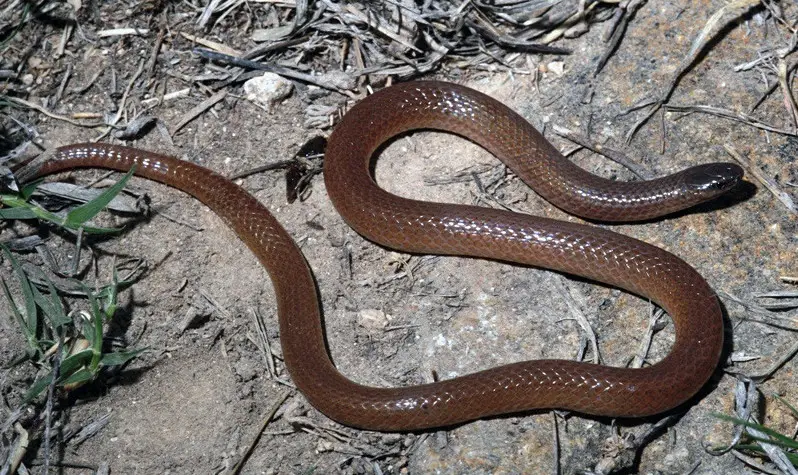
The Flat-headed Snake is a small, slender species, usually measuring 7 to 10 inches in length. It has smooth scales with a light brown or tan body and a distinctive darker head, giving it its name. The scales are shiny, and the snake has a delicate, streamlined form.
This snake inhabits the central and eastern parts of Texas, favoring rocky woodlands, grasslands, and sandy soils. It is nocturnal and secretive, often hiding under rocks, logs, or leaf litter during the day. Its flattened head helps it move easily through tight spaces underground.
Flat-headed Snakes primarily feed on small invertebrates like insects, spiders, and centipedes. It is non-venomous and harmless to humans. When disturbed, it may release a foul-smelling musk as a defense mechanism.
Texas Patch-nosed Snake (Salvadora grahamiae lineata)

The Texas Patch-nosed Snake is a slender, fast-moving snake that grows to about 20 to 30 inches long. It is named for the distinctive scale, or “patch,” on its nose, which is slightly upturned. The snake’s coloration is typically tan or gray with faint longitudinal stripes.
This species is common in central and western Texas, where it inhabits arid scrublands, deserts, and grasslands. It is diurnal and known for its speed and agility. The Texas Patch-nosed Snake is often found actively hunting during the day.
It preys primarily on lizards, small rodents, and occasionally birds and eggs. Non-venomous and harmless to humans, it kills prey by biting and swallowing them alive. Its upturned nose assists in digging and navigating through loose soil.
Texas Brown Snake (Storeria dekayi texana)

The Texas Brown Snake is a small to medium-sized snake, averaging 10 to 16 inches in length. It has a smooth-scaled body colored brown or gray with a faint stripe running down its back. This subspecies is common across much of Texas.
It favors moist habitats such as woodlands, gardens, and marshy areas, often hiding under logs, rocks, or leaf litter. The Texas Brown Snake is primarily nocturnal or crepuscular and is shy, rarely seen during the day.
Its diet mainly consists of earthworms, slugs, and small amphibians. It is non-venomous and completely harmless to humans. This snake plays a beneficial role in controlling garden pests.
Dekay’s Brown Snake (Storeria dekayi)

Dekay’s Brown Snake is similar in appearance to the Texas Brown Snake but tends to be slightly smaller, generally 7 to 13 inches long. It has smooth scales and a brown or gray body with two rows of dark spots or blotches running along its back.
This snake is widespread in eastern Texas, inhabiting forests, suburban areas, and gardens. It prefers moist, sheltered environments and is often found under rocks or debris. Dekay’s Brown Snake is nocturnal and secretive.
Its diet mainly includes slugs, earthworms, and soft-bodied insects. It is non-venomous and harmless to humans. Due to its small size and reclusive habits, it is rarely noticed by people.
Black-necked Garter Snake (Thamnophis cyrtopsis)
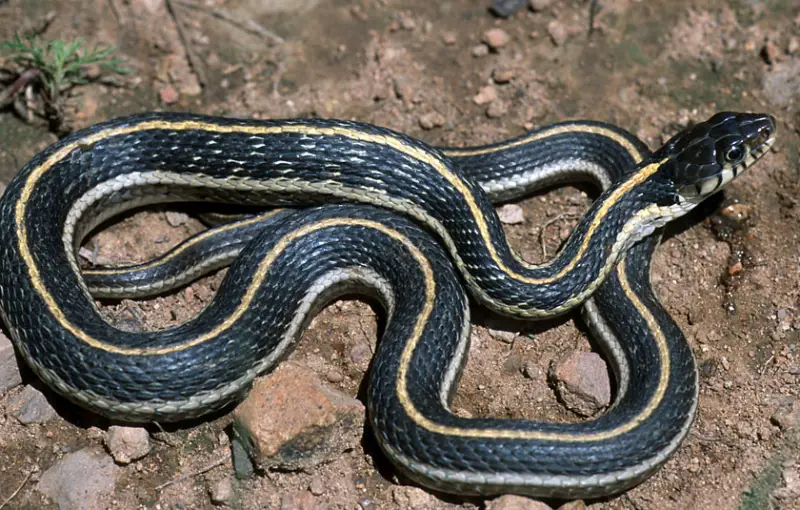
The Black-necked Garter Snake is a medium-sized, slender snake typically ranging from 18 to 30 inches in length. It is easily recognized by its distinctive black coloration on the neck and head, which contrasts with its olive or brown body and yellow or orange stripes running along the sides. Its smooth scales and streamlined body aid in its agility both on land and in water.
In Texas, this species is found mainly in the southern and western parts, often near streams, rivers, ponds, and wetlands where it thrives. The Black-necked Garter Snake is primarily diurnal, spending much of its time actively hunting in and around water. It is a strong swimmer and frequently seen basking on rocks or logs near water bodies.
Its diet is varied and consists mostly of amphibians such as frogs and toads, fish, small reptiles, and aquatic insects. Non-venomous and completely harmless to humans, this snake relies on speed and agility to capture prey and evade predators. When threatened, it may flatten its body and release a musky scent as a defense mechanism.
Red-sided Garter Snake (Thamnophis proximus parietalis)
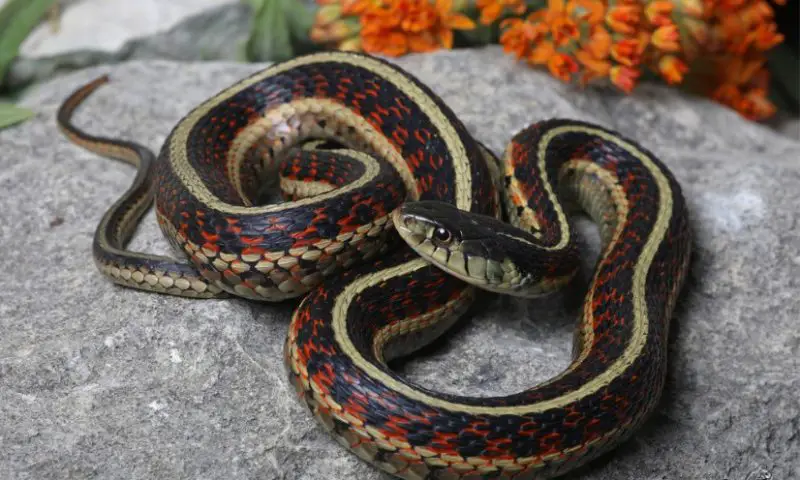
The Red-sided Garter Snake is a slender, medium-sized snake measuring between 18 and 30 inches long. It is noted for its vibrant red or orange stripes running along the sides of a dark green or black body, with lighter yellow or cream-colored stripes along the back. Its bright coloration makes it relatively easy to identify in its natural habitat.
This snake is commonly found in eastern and central Texas, favoring moist environments such as marshes, swamps, and grassy fields near water. It is a diurnal species and spends much time actively searching for food or basking in the sun to regulate its body temperature.
The Red-sided Garter Snake primarily feeds on amphibians, small fish, worms, and various insects. It is non-venomous and poses no threat to humans. Its quick movements and secretive behavior help it avoid predators, while its diet helps control populations of aquatic pests.
Southern Black Racer (Coluber constrictor priapus)
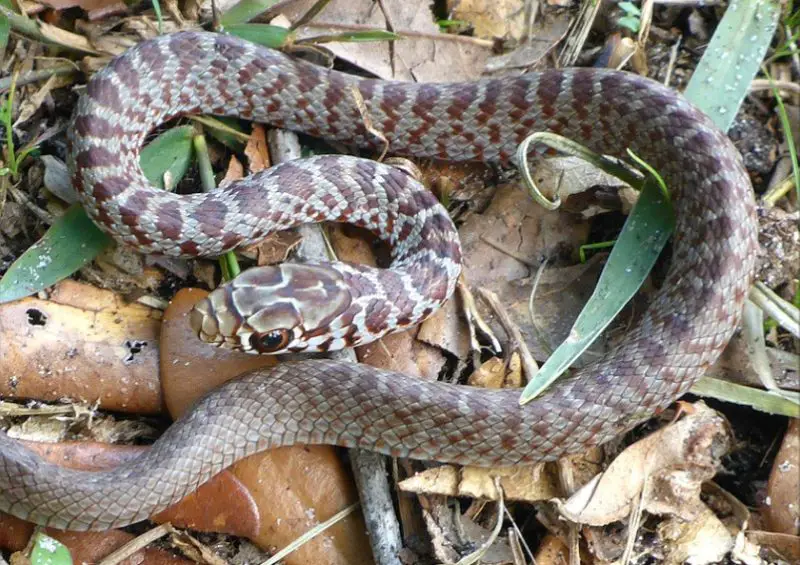
The Southern Black Racer is a large, slender, and fast snake, usually ranging from 36 to 60 inches in length. It has a glossy black body with smooth scales and a white or gray underside. Its streamlined form and large eyes give it keen eyesight, making it an excellent hunter during the day.
This species is widespread throughout Texas, commonly inhabiting open woodlands, grasslands, and suburban areas. It is highly active and diurnal, known for its remarkable speed and agility, often fleeing rapidly when threatened. The Southern Black Racer is also a good climber and can be found in low trees or shrubs.
Its diet is varied and includes rodents, birds, lizards, frogs, and insects. It is non-venomous and kills prey by biting and swallowing it whole. While generally non-aggressive toward humans, it may vibrate its tail or release a foul musk when disturbed as a defense.
Eastern Coachwhip (Masticophis flagellum flagellum)
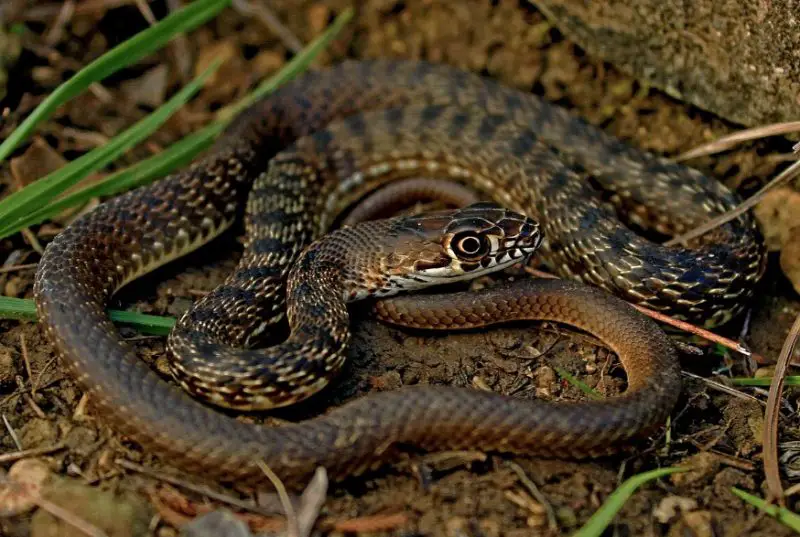
The Eastern Coachwhip is a large, slender snake that can grow up to 72 inches long or more. It has a distinctive braided appearance, with its scales arranged in a pattern resembling a whip. The coloration varies from light brown or tan near the head to darker shades toward the tail, providing excellent camouflage in its natural habitat.
Found in eastern and southeastern Texas, this snake prefers open areas such as grasslands, sandy soils, and pine forests. It is diurnal and highly active, relying on its speed and excellent vision to catch prey. The Eastern Coachwhip is known for its alertness and curious nature, often investigating potential threats rather than fleeing immediately.
Its diet consists mainly of lizards, small mammals, birds, and other snakes. Non-venomous and harmless to humans, it subdues prey by biting and quickly swallowing it. When threatened, it may strike repeatedly but rarely bites defensively.
Western Coachwhip (Masticophis flagellum testaceus)
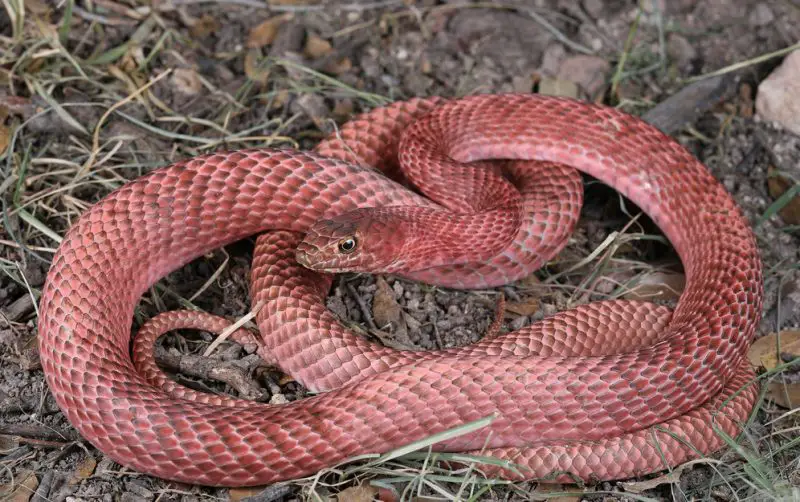
The Western Coachwhip is similar in size and build to the Eastern Coachwhip, typically measuring 48 to 72 inches in length. It has smooth scales with coloration ranging from light tan or reddish-brown near the head to darker brown or blackish toward the tail. The braided scale pattern resembles a whip, which inspired its common name.
This species inhabits western Texas and is commonly found in arid or semi-arid regions such as deserts, scrublands, and open woodlands. It is diurnal and highly active, using its speed and keen eyesight to hunt and avoid predators. The Western Coachwhip is a strong climber and frequently uses vegetation for cover.
It feeds on a wide variety of prey, including lizards, rodents, birds, and other snakes. It is non-venomous and kills prey by biting and swallowing. Generally shy, the Western Coachwhip may display defensive behavior such as tail whipping or rapid movements to deter threats but is not aggressive toward humans.
Texas Long-nosed Snake (Rhinocheilus lecontei tessellatus)
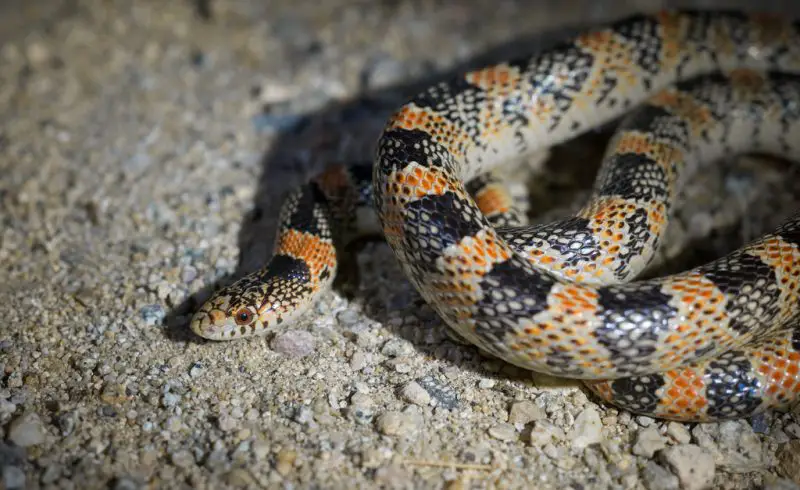
The Texas Long-nosed Snake is a slender and moderately sized species, generally measuring between 20 to 30 inches in length. It is easily identifiable by its long, pointed snout and distinct color pattern featuring alternating black, white, and red bands or blotches along its body. This striking coloration is a form of mimicry, resembling the venomous coral snake to deter predators.
Found primarily in western and central Texas, this snake favors arid and semi-arid habitats such as grasslands, rocky hillsides, and desert scrub. It is mostly nocturnal, seeking shelter under rocks or debris during the day and becoming active at night to hunt. The Texas Long-nosed Snake is secretive and rarely seen by humans.
Its diet mainly consists of lizards, small snakes, and amphibians. Non-venomous and harmless, it subdues prey by constriction or rapid swallowing. Despite its resemblance to venomous species, it poses no threat to humans and relies on its mimicry for protection.
Glossy Snake (Arizona elegans)
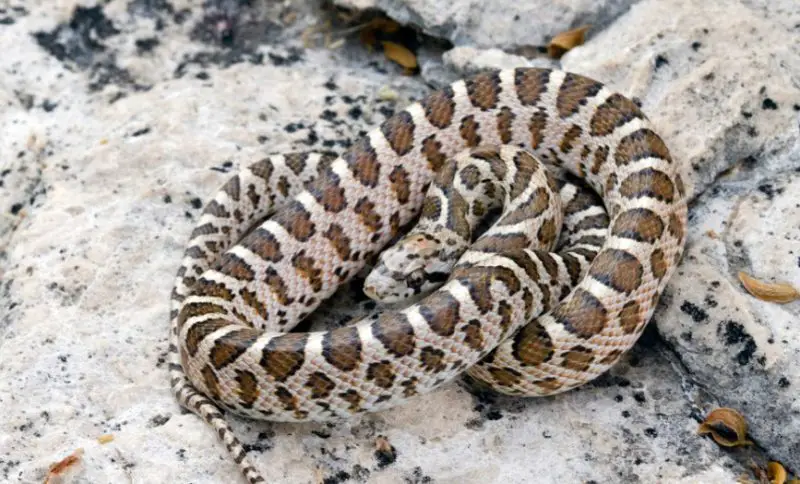
The Glossy Snake is a medium-sized, slender snake ranging from 20 to 40 inches in length. Its smooth, shiny scales give it a glossy appearance, often colored in tan or light brown with darker blotches or saddles running along its back. The head is slightly wider than the neck, with large eyes adapted for nocturnal hunting.
This species inhabits dry, open areas in western Texas, such as deserts, grasslands, and sandy soils. Primarily nocturnal, the Glossy Snake is active at night when it hunts small reptiles and rodents. During the day, it hides under rocks or burrows to avoid extreme heat.
Glossy Snakes are non-venomous and harmless to humans. Their diet includes lizards, small mammals, and occasionally amphibians. They rely on stealth and quick strikes to capture prey, swallowing it whole. When threatened, they may release a foul-smelling musk but rarely bite.
Texas Lyre Snake (Trimorphodon vilkinsonii)

The Texas Lyre Snake is a moderately sized, slender snake, typically measuring 20 to 30 inches long. It is named for the lyre-shaped markings on its head, with a pattern of dark bands or blotches over a tan or light brown background. Its large eyes and vertical pupils are adapted for nocturnal activity.
Found in rocky hillsides, canyons, and wooded areas of west and central Texas, the Texas Lyre Snake is primarily nocturnal and secretive. It spends the day hiding under rocks or in crevices and emerges at night to hunt. This species is an excellent climber and often ventures into shrubs and low trees.
Its diet includes lizards, small mammals, birds, and other snakes. The Texas Lyre Snake is mildly venomous, possessing rear fangs that help subdue prey, but its venom is not harmful to humans. It uses a combination of venom and constriction to immobilize prey before swallowing.
Western Worm Snake (Carphophis vermis)
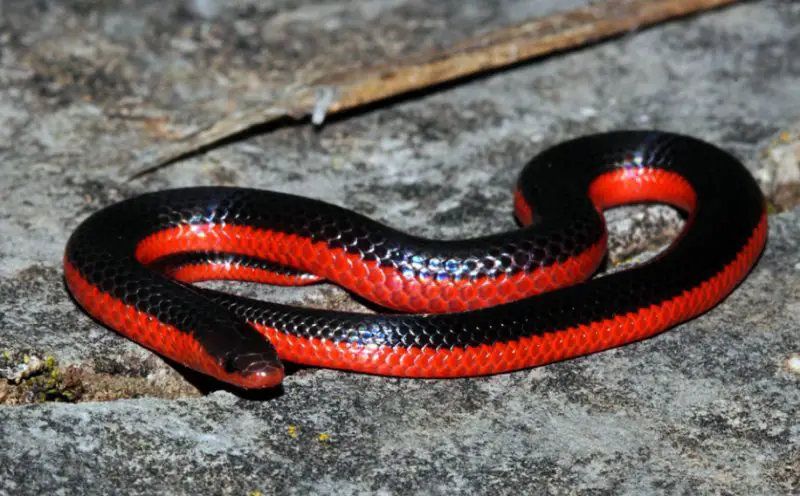
The Western Worm Snake is a small, slender snake, usually measuring 7 to 12 inches long. It has smooth, shiny scales with a uniform dark brown or purplish-black coloration on top and a lighter pink or reddish underside. Its small size and worm-like appearance help it move easily through soil and leaf litter.
This snake is found in eastern and northern Texas, favoring moist woodlands, forests, and grassy areas with abundant leaf litter and loose soil. It is fossorial, spending most of its time underground or beneath logs and rocks. It is primarily nocturnal or crepuscular, emerging at night or dusk to feed.
The Western Worm Snake feeds mainly on earthworms, insects, and other small invertebrates. It is non-venomous and harmless to humans. Due to its secretive nature, it is rarely seen but plays an important role in controlling soil invertebrate populations.
Brahminy Blind Snake (Indotyphlops braminus)

The Brahminy Blind Snake is a tiny, slender snake resembling an earthworm, typically only 2 to 6 inches long. It has smooth, shiny scales with a uniform pale brown or pinkish coloration and lacks visible eyes, as its eyes are vestigial and covered by scales. This snake is often mistaken for a worm due to its size and appearance.
This species is introduced and found in urban gardens, greenhouses, and moist soils in southern Texas. It is fossorial, spending nearly all its time underground or hidden beneath leaf litter and debris. It thrives in warm, moist environments and can be easily transported via plant materials.
The Brahminy Blind Snake feeds exclusively on ants and termites, consuming their eggs, larvae, and pupae. It is non-venomous and completely harmless to humans. Due to its secretive and subterranean lifestyle, it is rarely encountered despite being widespread.
Texas Lined Snake (Tropidoclonion lineatum texanum)

The Texas Lined Snake is a slender, small snake, typically measuring 12 to 18 inches in length. It is characterized by a distinct pattern of thin, dark longitudinal stripes running down its gray or tan body. Its smooth scales and small head make it agile and well-adapted for its environment. The snake’s coloration helps it blend into leaf litter and grassy areas.
This species is found in central and eastern Texas, preferring moist habitats such as wetlands, marsh edges, and grassy fields. It is primarily nocturnal and secretive, often hiding under rocks, logs, or dense vegetation during the day. The Texas Lined Snake is a good swimmer and is occasionally seen near bodies of water.
Its diet mainly consists of earthworms, slugs, and other small invertebrates. Non-venomous and harmless, it poses no threat to humans. This snake uses its slender body to navigate through soil and leaf litter, aiding in controlling invertebrate populations.
Western Ground Snake (Sonora semiannulata)
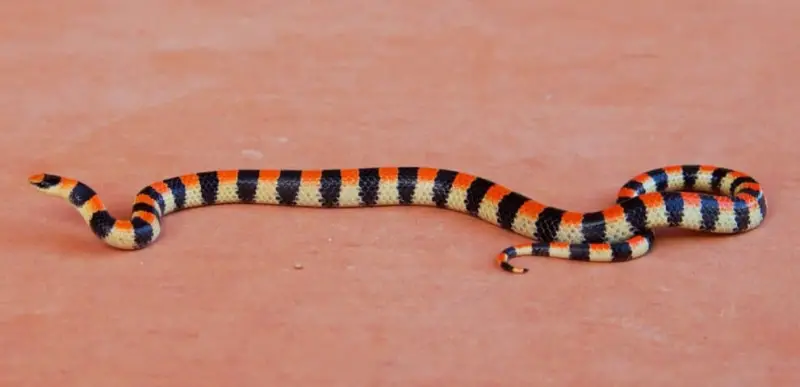
The Western Ground Snake is a small, slender species usually measuring between 10 to 15 inches. It features a distinctive pattern of black, brown, or reddish bands or blotches on a lighter background, with smooth scales that give it a glossy appearance. Its small size and coloration make it well camouflaged in rocky or sandy environments.
This snake is found in western Texas, favoring dry, open areas such as deserts, rocky hillsides, and scrublands. It is mostly nocturnal and elusive, spending much of its time under rocks or in burrows. The Western Ground Snake is known for its secretive behavior, making sightings rare.
Its diet consists mainly of small insects, spiders, and occasionally small lizards. It is non-venomous and harmless to humans. The Western Ground Snake plays an important ecological role by helping control insect populations in its arid habitat.
Chihuahuan Hook-nosed Snake (Gyalopion canum)
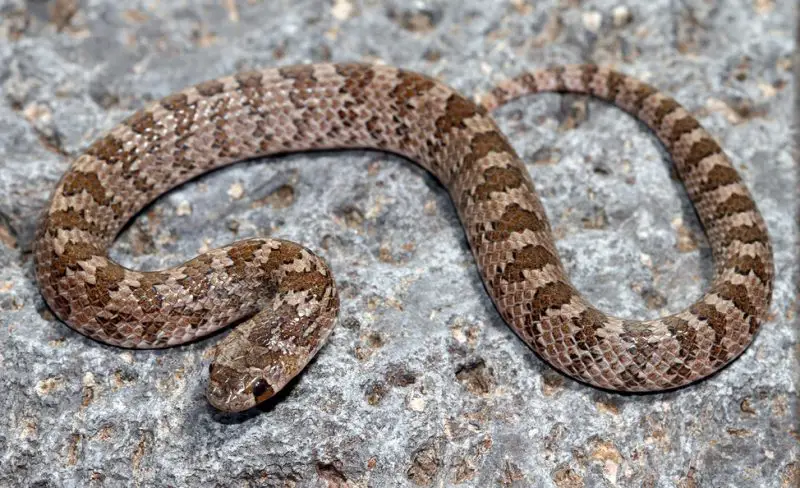
The Chihuahuan Hook-nosed Snake is a small to medium-sized species, measuring around 12 to 18 inches. It gets its name from the slightly upturned tip of its snout, which aids in digging and burrowing. Its coloration is generally light brown or gray with darker blotches or crossbands along its back.
This snake inhabits the Chihuahuan Desert region, including western Texas, where it prefers sandy or rocky soils. It is primarily nocturnal and spends much of its time underground or under debris to avoid the harsh daytime heat. It is a shy and secretive species seldom seen by humans.
Its diet mainly includes small reptiles, amphibians, and insects. Non-venomous and non-aggressive, it uses quick strikes to catch prey. It relies on burrowing for protection and hunting, playing a role in the desert ecosystem by controlling small animal populations.
Mexican Hook-nosed Snake (Gyalopion quadrangulare)

The Mexican Hook-nosed Snake is similar in size to the Chihuahuan Hook-nosed Snake, typically ranging from 12 to 18 inches long. It also has an upturned snout, which helps in digging through loose soil. Its body coloration varies from pale tan to light brown with darker markings along its back.
This species is found in southern and western Texas, often inhabiting desert and semi-arid areas with sandy or gravelly soils. It is nocturnal and fossorial, spending much of its time underground or hidden beneath rocks and leaf litter. Its shy nature makes it a rarely encountered snake.
The Mexican Hook-nosed Snake feeds on small lizards, insects, and spiders. It is non-venomous and harmless to humans. Its burrowing habits aid in soil aeration, and it plays a role in maintaining balance in desert food webs.
Texas Threadsnake (Leptotyphlops dulcis)

The Texas Threadsnake is one of the smallest snakes in Texas, measuring only about 4 to 7 inches long. It resembles an earthworm with its slender, smooth, and shiny body, typically light brown or pinkish in color. It has vestigial eyes covered by scales, making it nearly blind and reliant on other senses.
This fossorial snake is found throughout much of Texas, preferring loose, sandy, or loamy soils in grasslands, woodlands, and suburban areas. It spends nearly all its life underground, burrowing through soil or leaf litter. It is rarely seen due to its secretive and subterranean lifestyle.
Its diet consists mainly of ants and termites, feeding on their eggs and larvae. The Texas Threadsnake is non-venomous and completely harmless to humans. It plays an important ecological role in controlling ant and termite populations underground.
Texas Swamp Snake (Liodytes rigida sinicola)
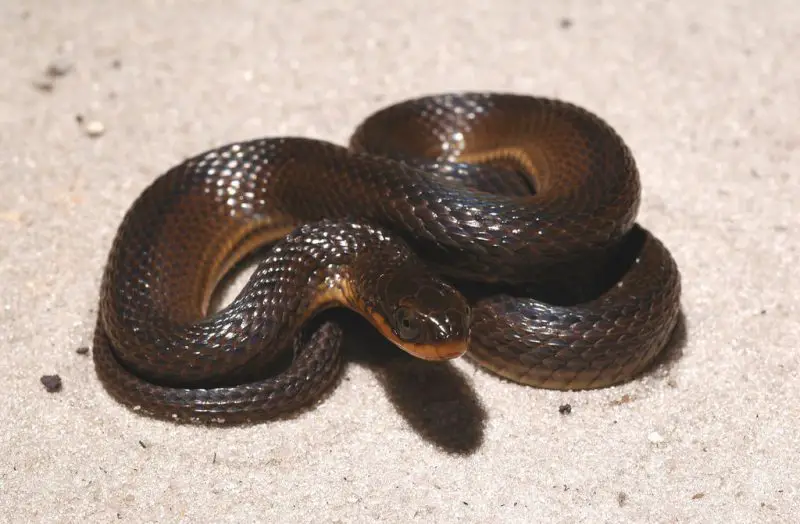
The Texas Swamp Snake is a small to medium-sized, slender snake, typically measuring 12 to 20 inches in length. It has a glossy, dark olive or brownish body with faint lighter markings, which provides excellent camouflage in its watery habitats. Its smooth scales and streamlined body help it move easily through aquatic vegetation.
This species is primarily found in southeastern Texas, inhabiting slow-moving or stagnant waters such as swamps, marshes, ponds, and slow streams. It is semi-aquatic and spends much of its time in or near water, often hiding under debris or aquatic plants during the day. It is mostly active during the day (diurnal) but can also be seen at dusk.
The Texas Swamp Snake feeds mainly on amphibians such as frogs, tadpoles, and salamanders, as well as small fish and invertebrates. It is non-venomous and harmless to humans. Its aquatic lifestyle makes it an important predator in wetland ecosystems, helping to regulate amphibian populations.
Texas Scarlet Snake (Cemophora coccinea lineri)
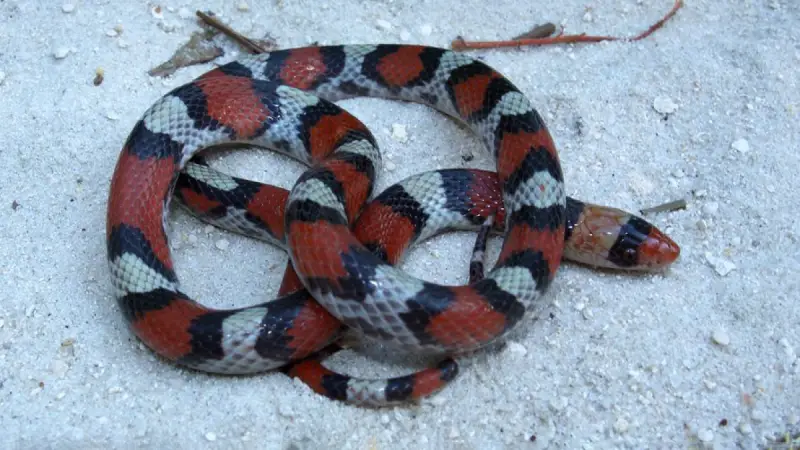
The Texas Scarlet Snake is a small, slender snake, usually around 14 to 20 inches long. It is brightly colored with alternating red, black, and yellow or white bands, often mistaken for the venomous coral snake. Its smooth scales and vibrant colors serve as a warning mimic, though it is non-venomous.
This snake is found in central and eastern Texas, inhabiting sandy woodlands, pine forests, and areas with loose soil suitable for burrowing. It is secretive and fossorial, spending much of its time underground or beneath logs and leaf litter. It is mostly nocturnal or crepuscular, emerging at night or twilight to hunt.
The Texas Scarlet Snake preys mainly on reptile eggs, particularly those of other snakes and lizards, using its slender head to enter nests. It is non-venomous and poses no threat to humans. This snake plays a valuable role in controlling populations of other reptiles by feeding on their eggs.
Louisiana Pine Snake (Pituophis ruthveni)

The Louisiana Pine Snake is a large and rare species, reaching lengths of up to 6 feet. It has a robust body with a pattern of dark blotches on a yellow or tan background. Its scales are keeled, giving it a rough texture, and it has a distinctive, somewhat flattened head.
This snake is found mainly in the pine forests of eastern Texas and Louisiana, where it prefers sandy soils and open woodlands. It is primarily terrestrial and fossorial, spending much time burrowing in loose soil or beneath logs. It is shy and secretive, making sightings uncommon.
The Louisiana Pine Snake feeds mainly on small mammals, especially rodents, which it subdues by constriction. It is non-venomous and harmless to humans. Because of habitat loss, it is considered a threatened species, and it plays an important role in controlling rodent populations in pine forest ecosystems.
Texas Hook-nosed Snake (Ficimia streckeri)

The Texas Hook-nosed Snake is a small, slender snake measuring 10 to 15 inches. It has a distinctive upturned snout used for digging in loose soil and sandy environments. Its coloration varies from gray to light brown, with darker spots or blotches along the back.
This species is found in central and southern Texas, typically inhabiting rocky or sandy woodlands and shrublands. It is primarily nocturnal and fossorial, spending much of its time underground or hidden beneath rocks and debris. It is shy and rarely seen in the wild.
The Texas Hook-nosed Snake feeds mostly on spiders, scorpions, and small insects. It is non-venomous and harmless to humans. Its specialized diet and burrowing behavior help it maintain balance in its habitat by controlling populations of arthropods.
Ring-necked Snake (Diadophis punctatus)

The Ring-necked Snake is a small, slender snake, usually 10 to 15 inches long. It is easily identified by its gray or black body and a distinct yellow or orange ring around its neck. The underside is often bright yellow or orange with small black spots.
This snake is widespread throughout Texas, occupying diverse habitats including woodlands, grasslands, rocky hillsides, and suburban areas. It is mostly nocturnal and secretive, often hiding under logs, rocks, or leaf litter during the day. It is known for its gentle temperament.
The Ring-necked Snake feeds primarily on small amphibians, salamanders, earthworms, and insects. Although it has mild venom used to subdue prey, it is harmless to humans. This snake plays a beneficial role in controlling populations of small invertebrates and amphibians.
Blotched Water Snake (Nerodia erythrogaster transversa)
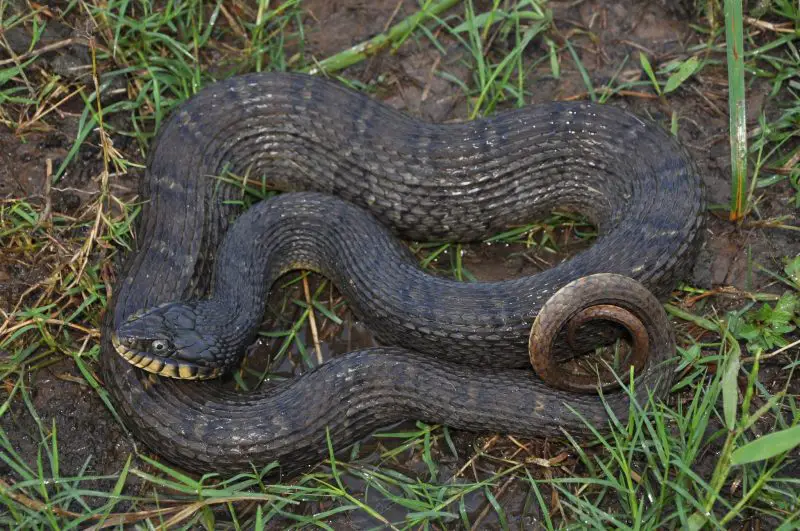
The Blotched Water Snake is a medium to large non-venomous snake, typically reaching lengths of 24 to 48 inches. It has a robust body with dark blotches or bands on a lighter brown or gray background. Its scales are keeled, giving it a rough texture, and it has a broad head slightly wider than the neck.
This species inhabits slow-moving waters, such as rivers, lakes, ponds, and swamps throughout eastern and central Texas. It is highly aquatic and an excellent swimmer, often found basking on logs or rocks near water. It is active mainly during the day but may also be seen at dusk.
The Blotched Water Snake preys primarily on fish and amphibians, using its strong jaws to catch slippery prey. It is non-venomous but can be defensive if threatened, often releasing musk or striking. Despite this, it poses no real danger to humans and plays an important role in controlling aquatic prey populations.
Diamondback Water Snake (Nerodia rhombifer)
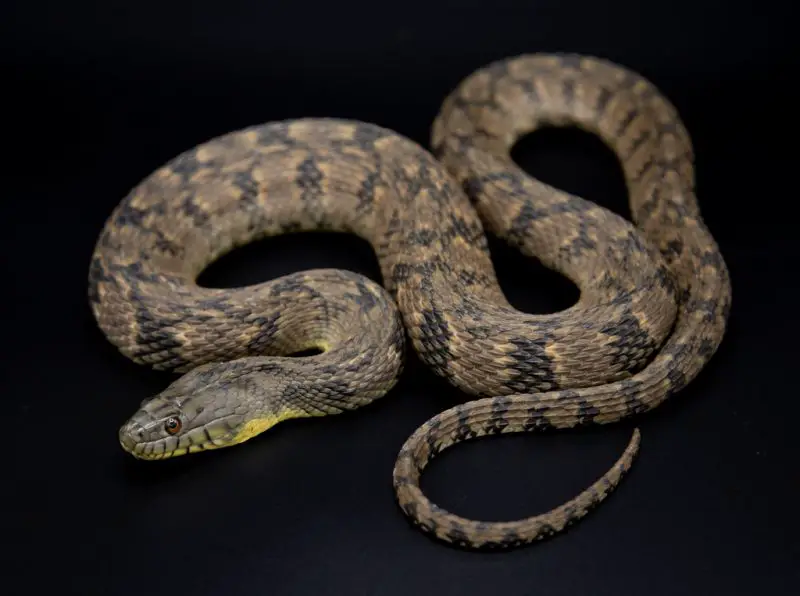
The Diamondback Water Snake is a large, heavy-bodied snake, usually 30 to 55 inches in length. It is named for the diamond-shaped pattern running along its back, with dark brown or black markings on a lighter brown or tan background. The scales are keeled, providing a rough texture.
Found throughout eastern Texas near slow-moving or still water bodies like ponds, marshes, and bayous, this snake is primarily aquatic. It is often seen basking on rocks or branches near water and is an excellent swimmer and hunter in aquatic environments.
The Diamondback Water Snake feeds mainly on fish, frogs, and other small aquatic animals. It is non-venomous and generally avoids confrontation but can defend itself by striking or releasing a foul-smelling musk. It contributes to maintaining healthy aquatic ecosystems by controlling prey populations.
Green Water Snake (Nerodia cyclopion)

The Green Water Snake is a large, robust snake measuring 24 to 48 inches. Its coloration varies from olive to greenish-brown, with darker blotches or bands on the back and sides. The scales are keeled, and its head is broad with prominent eyes.
This species inhabits freshwater environments such as swamps, bayous, and slow-moving rivers primarily in southeastern Texas. It is highly aquatic and spends much time swimming or basking near water edges. It is mostly active during the day but can also be nocturnal.
The Green Water Snake preys on fish, frogs, and occasionally crayfish and other aquatic animals. It is non-venomous and may become defensive if handled, but it poses no significant risk to humans. This snake is an important predator in wetland ecosystems, helping balance aquatic food webs.
Plain-bellied Water Snake (Nerodia erythrogaster)
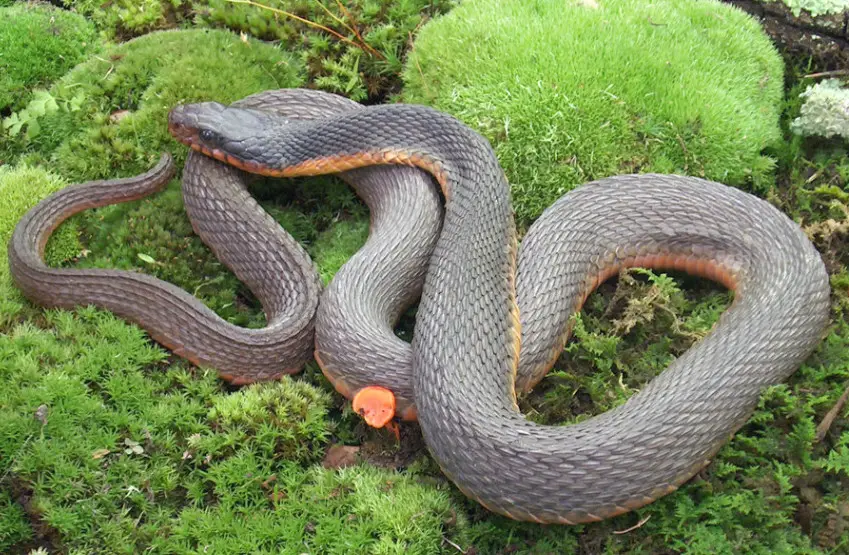
The Plain-bellied Water Snake is a medium to large-sized snake, typically 24 to 48 inches long. It is distinguished by its plain, unmarked belly, usually cream, yellow, or light orange, contrasting with its patterned dorsal side of dark blotches or bands on brown or gray.
This species favors slow-moving waters such as swamps, marshes, ponds, and rivers across much of Texas. It is highly aquatic, spending most of its time in or near water, often basking on logs or rocks. It is diurnal but can be active at twilight.
The Plain-bellied Water Snake feeds primarily on fish, amphibians, and sometimes small mammals. It is non-venomous but may strike or release musk if threatened. As a common aquatic predator, it plays a vital role in regulating prey species within freshwater ecosystems.
Texas Glossy Snake (Arizona elegans arenicola)

The Texas Glossy Snake is a medium-sized, slender snake ranging from 18 to 36 inches in length. It has smooth, shiny scales that give it a glossy appearance, with a tan or grayish body patterned with darker blotches or spots. Its head is slightly distinct from the neck, and the eyes are large with round pupils.
This species inhabits arid and semi-arid regions in western and central Texas, including deserts, scrublands, and rocky hillsides. It is primarily nocturnal and secretive, spending much of its time underground or hiding beneath rocks and debris during the day.
The Texas Glossy Snake preys mainly on small lizards, rodents, and occasionally snakes. It is non-venomous and uses constriction to subdue its prey. Its elusive behavior and habitat preferences make it less frequently encountered by people, but it is an important predator in desert ecosystems.
Gray-banded Kingsnake (Lampropeltis alterna)
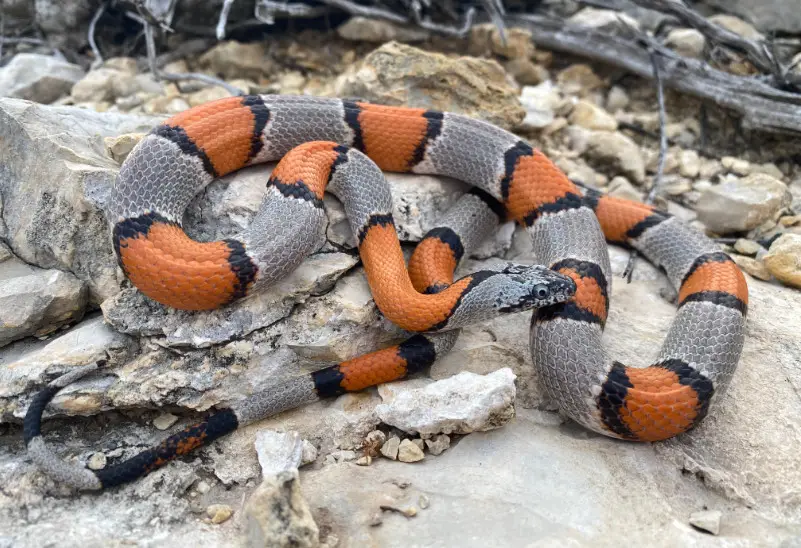
The Gray-banded Kingsnake is a small to medium-sized snake, usually 20 to 30 inches long. It features distinctive gray or blue-gray bands alternating with black or dark brown bands across its body. The scales are smooth, and the snake has a slender, agile build.
This species is native to the rocky limestone hills and canyons of western Texas, where it prefers semi-arid habitats with abundant cover such as rocks and shrubs. It is primarily nocturnal and secretive, often hiding beneath rocks or in crevices during the day.
The Gray-banded Kingsnake is a non-venomous constrictor feeding mainly on lizards, small snakes, and rodents. It is known for its docile nature and is sometimes kept as a pet due to its striking coloration. In its natural habitat, it helps regulate populations of small reptiles and mammals.


